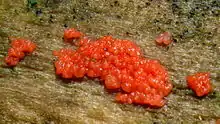| Tulasnella aurantiaca | |
|---|---|
 | |
| Tulasnella aurantiaca, Ohio, USA | |
| Scientific classification | |
| Domain: | Eukaryota |
| Kingdom: | Fungi |
| Division: | Basidiomycota |
| Class: | Agaricomycetes |
| Order: | Cantharellales |
| Family: | Tulasnellaceae |
| Genus: | Tulasnella |
| Species: | T. aurantiaca |
| Binomial name | |
| Tulasnella aurantiaca (Bonord.) J. Mack & Seifert (2021) | |
| Synonyms | |
Tulasnella aurantiaca is a species of fungus in the order Cantharellales. It produces orange-red, pustular, gelatinous anamorphic states on dead, deciduous wood. Originally described from Europe, it also occurs in North America where the species appears to be more common.
Taxonomy
Tulasnella aurantiaca was first published in 1851 by German mycologist Hermann Friedrich Bonorden who placed it in a new genus, Hormomyces. Microscopically, the species produces branched chains of hyaline, globose conidia and no teleomorphic (basidia-bearing) state is known. As a result, its disposition and relationships have long been uncertain. French mycologist Narcisse Théophile Patouillard suggested that Hormomyces aurantiacus was an anamorph of a Dacrymyces species.[1] Italian mycologist Pier Andrea Saccardo later suggested that H. aurantiacus might be the anamorph of Tremella mesenterica,[2] a view accepted by influential Dutch mycologist M.A. Donk.[3] Molecular research, based on cladistic analysis of DNA sequences, has, however, shown that the species is an anamorphic member of the genus Tulasnella.[4]
References
- ↑ Patouillard N. (1900). Essai taxonomique sur les familles et les genres des Hyménomycètes. Lons-Le-Saunier: Lucien Declume.
- ↑ Saccardo PA (1916). "Hymeniales (ceterae Agaricaceae, Polyporaceae, Hydnaceae, Thelephoraceae, Tremellaceae)". Flora Italica Cryptogama Fungi. 1: 577−1386.
- ↑ Donk MA (1962). "The generic names proposed for Hymenomycetes XII. Deuteromycetes". Taxon. 11 (3): 75−104. doi:10.2307/1216021. JSTOR 1216021.
- ↑ Mack J, Assabgui RA, Seifert KA (2021). "Taxonomy and phylogeny of the basidiomycetous hyphomycete genus Hormomyces". Fungal Systematics and Evolution. 7: 177–196. doi:10.3114/fuse.2021.07.09. PMC 8166209. PMID 34124623.